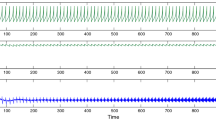Conclusions
-
1.
Investigations on a mathematical model have shown that the presence of an optimal system of parameters of neuron-like excitatory elements (EE) and of connections between them is essential for the undistorted conduction of excitation along a network composed of them. If these parameters deviate from their optimal values excitation will be transmitted along the net either with attenuation or with amplification, due to the presence of divergence and convergence of influences of EE of the preceding layer of the net on the succeeding layer.
-
2.
Optimal values of the parameters of EE and of the connections between them for undistorted conduction of excitation are not strictly determined. Deviations of some parameters can be compensated by changes in others.
-
3.
The presence of dispersion of thresholds of EE induces chaos in the working of the net, weakens the degree of synchronization in the activation of EE to an external agency, and impairs the detection of activity of input EE at the output of the net.
-
4.
Background activity of the net, both tonic and periodic, above the threshold for impulse generation prevents the appearance of activation of input EE at the output of the net, whereas near-threshold tonic activity of the net facilitates the conduction of excitation along it.
-
5.
Periodic below-threshold activity of the net facilitates the conduction of excitation along it only in the presence of optimal proportions of frequencies and phase shift of coherent rhythmic oscillations of excitability of EE, and also of the time required for excitation to be transmitted from the input of the net to its output. If those conditions are not present, the presence of below-threshold rhythmic oscillations of excitability (including high-frequency oscillations) in the net will limit the conduction of excitation along it by comparison with tonic below-threshold activation.
Similar content being viewed by others
Literature cited
D. A. Vasilenko and P. G. Kostyuk, “Phasic and tonic components of pyramidal influences on motoneurons,” Dokl. Akad. Nauk SSSR,169, No. 3, 731 (1966).
V. Yu. Krylov, T. V. Ostryakova, and G. I. Shul'gina, “On a model of the influence of rhythmic fluctuations of potential on conduction of excitation,” Zh. Vyssh. Nerv. Deyat.,24, No. 1, 124 (1974).
M. N. Livanov, “Neurokinetics,” in: Problems in Modern Neurophysiology [in Russian], Nauka, Moscow (1965), p. 37.
M. N. Livanov, V. A. Kravchenko, and T. A. Korol'kova, “Functional significance of cerebral cortical biopotentials,” Byull. Éksp. Biol. Med.,64, No. 11, 14 (1967).
A. M. Melekhova, G. I. Shul'gina, and A. N. Lebedev, “On some general principles of cortical neuronal activity in conscious rabbits,” Zh. Vyssh. Nerv. Deyat.,16, No. 5, 889 (1966).
V. G. Skrebitskii, Regulation of Conduction of Excitation in the Visual Analyzer [in Russian], Meditsina, Moscow (1977).
A. A. Frolov and G. I. Shul'gina, “A model of the conditions for conduction of excitation in a nerve net operating on different schedules,” in: Functional Significance of Electrical Processes of the Brain [in Russian], Nauka, Moscow (1977), p. 190.
A. A. Frolov, A. V. Medvedev, S. A. Dolina, et al., “A model of various patterns of brain electrical activity under normal conditions and with increased predisposition to epilepsy, based on a net of neuron-like elements,” Zh. Vyssh. Nerv. Deyat.,34, No. 3, 527 (1984).
G. I. Shul'gina, “On the functional role of slow waves of potential and of organized spike trains,” Usp. Fiziol. Nauk,7, No. 1, 47 (1976a).
G. I. Shul'gina, “Slow potentials and spike activity of cerebral cortical neurons during formation of internal inhibition,” Zh. Vyssh. Nerv. Deyat.,26, No. 5, 962 (1976).
G. I. Shul'gina and A. V. Korinevskii, “On the mechanism of action of a reinforcing stimulus,” Zh. Vyssh. Nerv. Deyat.,25, No. 5, 1016 (1975).
G. I. Shul'gina, N. K. Oblacheva, and A. Kh. Lyapkusova, “On interaction of specific and nonspecific afferentation in the rabbit visual cortex,” Zh. Vyssh. Nerv. Deyat.,22, No. 5, 1046 (1972).
G. I. Shul'gina, V. N. Ponomarev, G. B. Murzina, and A. A. Frolov, “A model of learning in a neuron net based on changes in the efficiency of excitatory and inhibitory synapses,” Zh. Vyssh. Nerv. Deyat.,33, No. 5, 926 (1983).
Y. Fujita and T. Sato, “Intracellular records from hippocampal pyramidal cells in rabbit during theta rhythm activity,” J. Neurophysiol.,27, No. 5, 1011 (1964).
F. Morell, “Electrical signs of sensory coding,” in: The Neurosciences, ed. by G. C. Quarton, Th. Melinichuk, and F. O. Schmitt, Rockefeller Univ. Press, New York, Vol. 2 (1967), p. 452.
D. P. Purpura and R. J. Shofer, “Intracellular recording from thalamic neurons during reticulocortical activation,” J. Neurophysiol.,26, No. 3, 494 (1963).
Author information
Authors and Affiliations
Additional information
Translated from Zhurnal Vysshei Nervnoi Deyatel'nosti imeni I. P. Pavlova, Vol. 38, No. 4, pp. 715–724, July–August, 1988.
Rights and permissions
About this article
Cite this article
Shuvgina, G.I., Ponomarev, V.N., Rez'ova, I.R. et al. Effect of background activity of a net of excitatory neuron-like elements on conduction of excitation. Neurosci Behav Physiol 19, 301–309 (1989). https://doi.org/10.1007/BF01236018
Received:
Issue Date:
DOI: https://doi.org/10.1007/BF01236018




